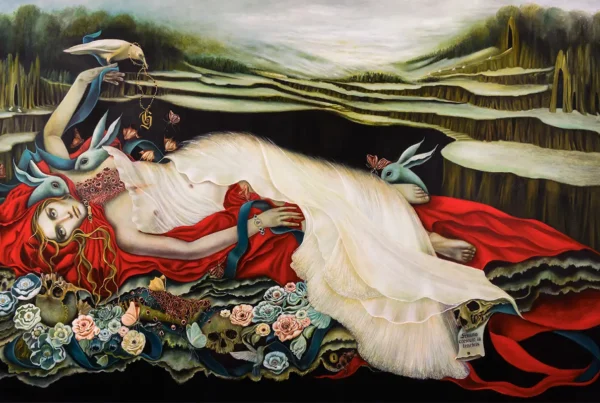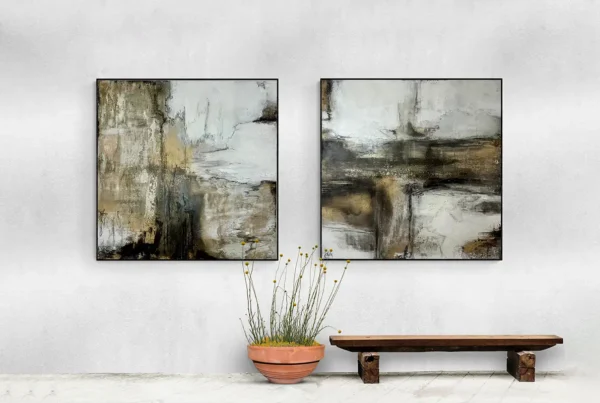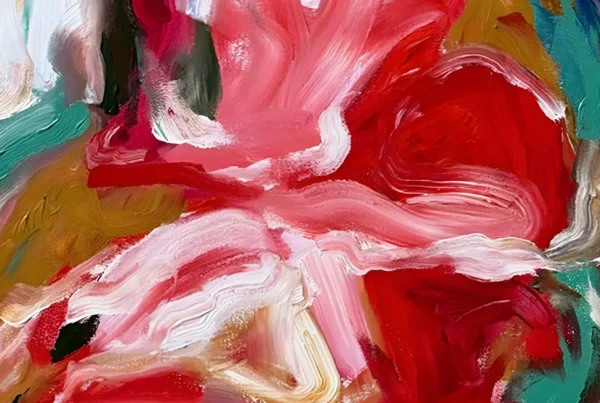Art at the Edge of Illusion
Sage Barnes has cultivated a visual language that defies categorization, offering a body of work that straddles clarity and chaos with unflinching originality. Known for his faceless portraits, Barnes constructs human figures with painstaking realism, only to replace their heads with bursts of color, texture, and unexpected objects—ranging from artificial flowers to neon signs and thick paint smears. These disfigured identities feel more like statements than distortions, challenging viewers to confront what defines a person beyond facial recognition. Rather than seeking neat resolutions, his paintings raise existential questions through contrasts: between the familiar and the abstract, the physical and the illusory, the personal and the collective.
Drawing comparisons to René Magritte, Barnes’s work modernizes the Surrealist impulse through contemporary materials and techniques. Each canvas operates not just as a visual experience but as a conceptual confrontation, where real objects—such as brushes, frames, and foam—emerge from the surface. This tactile dimension breaks the traditional flatness of portraiture and makes his art physically confrontational. By merging fine art with installation-like interventions, Barnes gives his compositions an illusionistic quality that invites the viewer to reconsider the boundaries between what is painted and what is constructed.
Barnes’s work signals a refusal to play by the rules of genre. Where traditional portraiture seeks to preserve identity, Barnes obscures it, urging the viewer to look inward rather than outward for meaning. His pieces, frequently inspired by street art and fueled by emotional honesty, speak to an audience that craves sincerity in a world saturated with curated images and digital personas. What begins as a headless figure soon becomes a mirror, reflecting back the anxieties, humor, and contradictions of modern life.

Sage Barnes: Unmasking the Everyday
Sage Barnes’s creative journey began not in an art academy, but through personal intuition and experimentation. Though he briefly attended the Fashion Institute of Design & Merchandising in Los Angeles, Barnes ultimately chose to pursue art on his own terms. Embracing the identity of a college dropout—boldly stated in his Instagram bio—he presents this narrative not as a rebellion, but as an invitation to rethink what it means to succeed creatively. His story is steeped in independence, and his evolution as an artist reflects a relentless pursuit of authenticity over convention.
Born in Missouri and now based in Kansas City, Barnes credits his grandmother, an oil painter, for inspiring him to pick up a brush. This early influence sparked a fascination with visual storytelling, which later expanded into a multidisciplinary practice. His current process involves a mix of precision and physical spontaneity, often captured in videos where he is seen flinging paint or physically breaking canvases. These acts of destruction aren’t random gestures—they serve as tools for reassembly, revealing abstract forms beneath the surface. By damaging his own work, Barnes underscores the idea that meaning can emerge from fracture, and that imperfection is integral to expression.
From his studio, aptly named “The Lab,” Barnes engages with his audience not only through visuals but also through words. Each social media post often features a quote or personal insight, pairing the visual piece with an emotional context. This dialogue adds depth to the work, turning each painting into a conversation. In doing so, Barnes dissolves the barrier between artist and viewer, transforming his platforms into spaces of reflection, community, and shared vulnerability.

Abstract Faces, Real Questions
At the heart of Barnes’s portfolio lies a fascination with duality: the coexistence of the visible and the hidden, the beautiful and the broken. His figures, often clad in business suits or casual streetwear, represent the grounded self. Yet, where we expect to see a face, we instead find a void filled with dynamic forms—splattered paint, balloon clusters, glowing smiles, or decaying flowers. These substitutions are not merely aesthetic choices; they act as visual metaphors for the shifting nature of identity and the masks people wear. In this sense, Barnes doesn’t erase the self; he reimagines it.
Recurring motifs like smiley faces and balloons inject a dose of playfulness into otherwise emotionally dense work. These icons, drawn from popular culture and digital shorthand, are recontextualized in his paintings to provoke deeper questions about authenticity and emotional transparency. A smiley face, often universally understood as a sign of happiness, becomes unsettling when used to replace a head, suggesting emotional displacement or enforced positivity. Similarly, his use of floral arrangements in place of faces brings nature into direct conflict with constructed identity, exploring how beauty can both conceal and reveal.
Barnes’s exploration of emotion often leans into discomfort, emphasizing that impactful art should stir something beneath the surface. His 2024 work “Reflection 9” and earlier piece “Bloom 6” are examples of this ethos, featuring sharply dressed torsos with vivid, chaotic forms where the face should be. These works compel viewers to contemplate the fragile nature of self-perception and how identity is shaped, obscured, or manipulated by external forces. Rather than resolving these tensions, Barnes allows them to linger, creating space for personal interpretation.

Sage Barnes: The Architecture of Contrast
Barnes’s practice thrives on contrast—not only in color and texture but also in thematic content. He intentionally juxtaposes opposing elements to evoke emotional complexity, whether through the collision of photorealistic detail with abstract chaos or the tension between structured form and spontaneous gesture. This friction becomes his most powerful tool. It enables his works to speak across stylistic boundaries, drawing in viewers who might be captivated by the precision of realism or the energy of street art, only to be pulled into something much deeper: a study of contradiction itself.
His technical range is as broad as his conceptual ambition. Working primarily with acrylic and spray paint, Barnes adds dimension through materials like stucco, neon, foam, and even shattered canvas. These additions push his work beyond the frame, both literally and figuratively. In some pieces, neon tubing coils across the surface; in others, physical objects pierce through the paint, blurring the line between two- and three-dimensional space. This approach not only redefines what a painting can be but also aligns with his ongoing interest in challenging the viewer’s expectations.
Barnes’s international success speaks to the resonance of his message. His works are part of private collections across North America and beyond, and his exhibitions in cities like New York, Los Angeles, and Miami have solidified his status as a contemporary voice to watch. Still, his focus remains on the act of creation—on engaging with materials in ways that surprise even him. Whether hammering through a canvas or flinging pigment across a wall, Barnes understands that expression often arises through contradiction. His art invites us to sit with that contradiction and consider what might grow from it.






